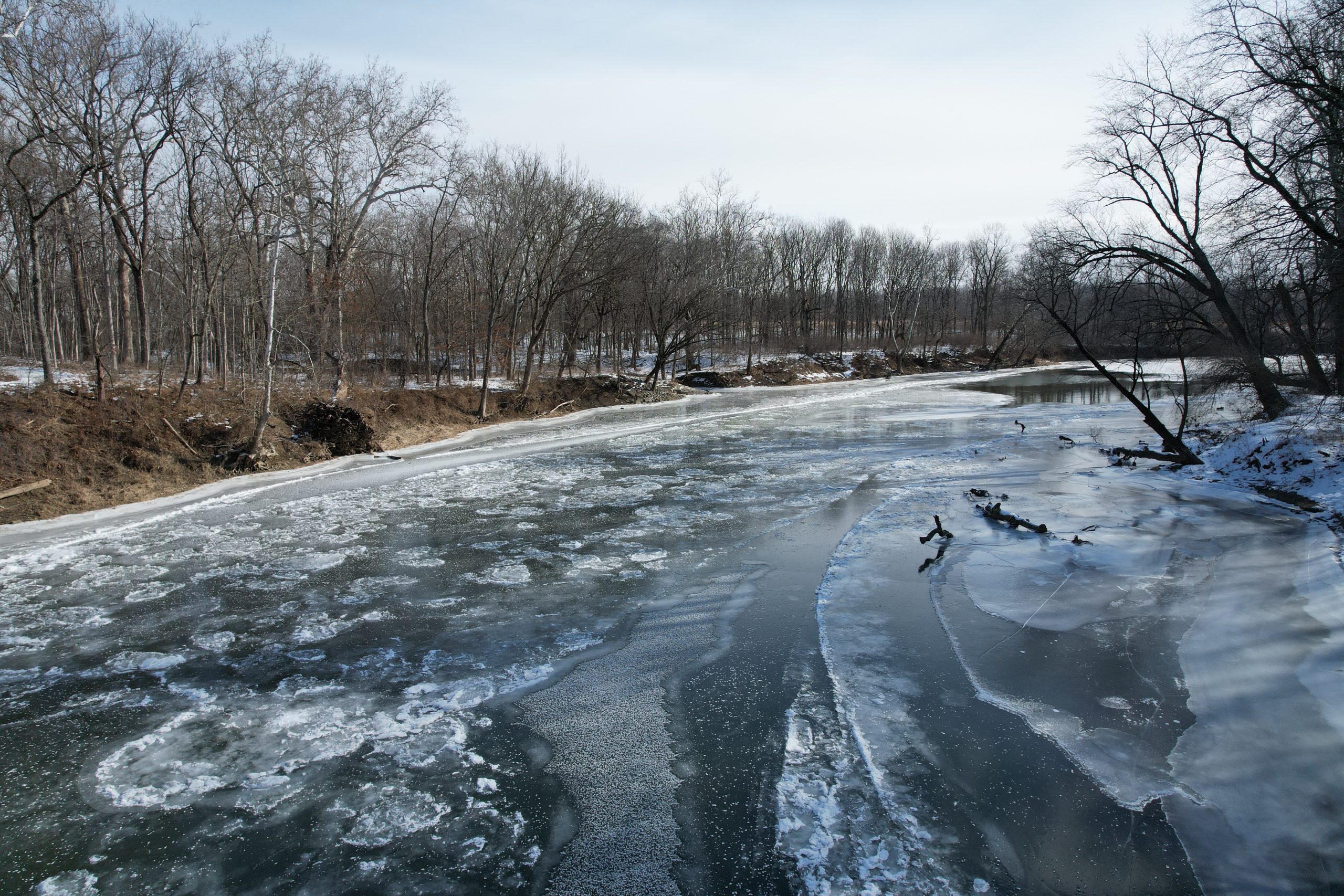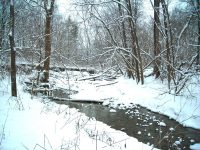
trillium forest floor res
Trillium now flourishes at Meltzer Woods
Meltzer Woods: A Wintercreeper Success Story
Written By: Jamison Hutchins
Date Published: April 11, 2022
Jamison Hutchins
In less than ten years, Meltzer Woods‘ wintercreeper problem has come under control.
What is wintercreeper? If you spend any time in a residential area, you will see this evergreen vine in gardens and/or climbing trees. For years, nurseries sold it as a groundcover, like English ivy.
But purple wintercreeper (Euonymus fortunei ‘Coloratus’) is highly invasive. Like many invasive plants that the stewardship team battles throughout our preserves, wintercreeper vines would not be an issue if they were contained to personal gardens. Wintercreeper joins honeysuckle, autumn olive and burning bush, among others, in finding their way out of the intended gardens and into natural areas.
There, wintercreeper can quickly smother out native vegetation by creating a dense mat of trailing vines. As native plants dwindle, so do the insects that rely on them. That impacts birds and, eventually, the entire food chain.

Wintercreeper in fruit
But the problems with wintercreeper only multiply from there.
When allowed to climb a tree, wintercreeper can reach heights of 50 feet, damaging the tree. Yet the most widespread harm starts much earlier, when the vines are just 10 to 15 feet long. That’s when wintercreeper produces flowers and then fruit. Birds snack on the berries and transport the plant to natural areas where the groundcover of choice is a diverse mix of native plants.
Meltzer Woods is a prime example of the havoc that wintercreeper can cause on a beautiful natural area. One of the many special places that CILTI protects and manages, Meltzer features a mile-long trail around some of the more amazing trees in the preserve. It is one of our best-loved and most-visited preserves.
But the woods today look very different than when we purchased it from the Meltzer family back in 2014, when there was a severe wintercreeper problem.
Even before CILTI took the property on, our executive director Cliff had worked with the family to address some of the most serious vines that were climbing century-old trees. But much of the forest floor was a “carpet” of the vining euonymus we call wintercreeper. It had all but created a monoculture on the ground, choking out natives that could not compete with the groundcover.
After CILTI acquired the woods, we could dedicate resources to addressing the infestation. This was done with the ongoing support of our wonderful members, as well as state programs like the Environmental Quality Incentives Program (EQIP) that help defray the cost of managing invasives like wintercreeper.
It took some early bombardment to knock it back, but we are now in a much better situation. The stewardship team spends a handful of days in the late fall and early spring spraying areas where it is popping back up in small patches. We have found that herbicides with the active ingredient Triclopyr are most effective in combatting the plant. We carefully select the windows of the year to spray, targeting times when the majority of the natives are dormant. This reduces the chance of hurting the plants we are championing.
So, what does life after wintercreeper look like at Meltzer Woods look like? Well, the springtime forest floor in most areas is back to the mix of spring ephemerals that one would have likely enjoyed before wintercreeper took over. Healthy populations of trilliums, jack-in-the pulpit and bellwort paint the ground with color. Even rarer species like putty root orchids thrive in areas that would have surely been covered in wintercreeper.
While the battle against wintercreeper has been an overall success, that doesn’t mean that we can walk away and let the woods be without ongoing management. Much of the regeneration has been positive, but we’ve also seen invasives like garlic mustard pepper the woods in the spring. These opportunistic plants require ongoing maintenance to eradicate.
Also, the woods on the parking lot side of the road (east) are not owned by CILTI. This area is heavily infested with wintercreeper. We have a management agreement in place with the owners and will be working on knocking it back as time allows. But until then, we will be dealing with a seedbank that only has to cross a two-lane street to get to our preserve.
As always, we thank our members and supporters for enabling us to carry on this important work, so that iconic places like Meltzer Woods can stay resilient and healthy into the future.
Want to help CILTI restore natural areas? Check out volunteer opportunities here. You can help us improve the health of forests and other natural habitats.

Ben Valentine
Guest Blogger
Ben Valentine is a founding member of the Friends of Marott Woods Nature Preserve and is active in several other conservation organizations. He leads a series of NUVO interviews with Indiana's environmental leaders, and he cherishes showing his son all the wonders of nature he grew up loving.

DJ Connors
Guest Blogger
DJ Connors, a Central Indiana native and late-to-life hunter, combines a lifelong appreciation for wildlife and the outdoors with a deep passion for exploring the natural beauty of the area he has called home for most of his life. As a husband and father of three, he is committed to ensuring his children have the same opportunities to connect with nature and appreciate the outdoors in their community. DJ’s unique journey into hunting emphasizes sustainability, responsible stewardship, and the importance of preserving these experiences for future generations.

Bridget Walls
Guest Blogger
Bridget is our first ever Communications and Outreach Intern. She is a graduate of Marian University, where she combined English, studio art, and environmental sciences in her degree studies. As treasurer for Just Earth, the university's environmental club, she helped plan events encouraging a responsible relationship between people, nature, and animals.

Jordan England
Guest Blogger
Jordan England is a lifelong Shelby County resident who graduated from Waldron Jr. Sr. High School (just a few miles from Meltzer Woods!). After earning her B.S. degree in Retail Management from Purdue University, she returned to Waldron to start a family with her husband, Brian. Together they have 3 young children and enjoy sharing with them their love of the community. Jordan is the Grants and Nonprofit Relations Director at Blue River Community Foundation, managing BRCF’s grant program, providing support to local nonprofits, and promoting catalytic philanthropy in Shelby County.

Cliff Chapman
President and CEO
As CILTI’s President and CEO, Cliff keeps CILTI’s focus on good science and stewardship. He’s mindful that the natural places you love took thousands of years to evolve and could be destroyed in a single day, and that knowledge drives his dedication to their protection.

Stacy Cachules
Chief Operating Officer
Among her many key duties as Assistant Director, Stacy has the critical task of tracking our budget, making sure we channel donations for maximum efficiency. When her workday’s done, Stacy loves to spend time with her two young boys—and when not traveling, she’s likely planning the next travel adventure.

Ryan Fuhrmann
Board Chair
Ryan C. Fuhrmann, CFA, is President and founder of Fuhrmann Capital LLC, an Indiana-based investment management firm focused on portfolio management. Ryan’s interest in land conservation centers around a desire to help preserve natural habitats for wildlife and the subsequent benefits it brings to people and the environment.

Joanna Nixon
Board Member
Joanna Nixon is the owner of Nixon Consulting, an Indianapolis-based strategy and project management firm focused on the nonprofit sector. She currently serves as the Philanthropic Advisor for the Efroymson Family Fund. Prior to opening her consulting practice in 2000, Joanna was vice-president for grantmaking at Central Indiana Community Foundation (CICF). Joanna has more than 25 years of experience in the nonprofit and arts and culture sector. She is passionate about the environment and loves bringing big ideas to life and creating high-quality arts and culture programs and experiences. Joanna enjoys outdoor adventures, including competing in fitness obstacle course races and hiking with her high energy Australian Cattle Dog, Jackson.

Karen Wade
Board Member
Before retiring, CILTI board member Karen Wade worked for Eli Lilly & Co. In retirement she volunteers for a number of organizations, including the Indiana Master Naturalist program, Johnson County Native Plant Partnership CISMA, Meadowstone Therapeutic Riding Center, and Leadership Johnson County.

David Barickman
Development Systems Manager
Born and raised in Central Illinois, David spent many days as a child wandering around the river, forest and lakes there. He works behind the scenes as a key member of our fundraising team. When not working, David loves to be outdoors hiking, fly fishing, kayaking or woodworking.

Jamison Hutchins
Stewardship Director
Jamison leads our stewardship team in caring for the land that is so important to you. He comes to our team after eight years as Bicycle and Pedestrian Coordinator for the city of Indianapolis, where his work had a positive impact from both health and environmental perspectives.

Jen Schmits Thomas
Media Relations
An award-winning communicator and recognized leader in Central Indiana’s public relations community, Jen helps us tell our story in the media. She is the founder of JTPR, which she and her husband John Thomas own together. She is accredited in public relations (APR) from the Public Relations Society of America, and loves to camp and hike in perfect weather conditions.

Shawndra Miller
Communications Director
Shawndra’s earliest writing projects centered around the natural world, starting when a bird inspired her to write her first “book” in elementary school. Now she is in charge of sharing our story and connecting you to our work. Through our print and online materials, she hopes to inspire your participation in protecting special places for future generations.

Phillip Weldy
Stewardship Manager
Phillip enjoys nature’s wonders from an up-close-and-personal perspective as he works to restore the natural places you love. As an AmeriCorps member in Asheville, NC, he had his first full immersion in relatively undisturbed land while reconstructing wilderness trails in National Parks and National Forests.


January 8, 2026
We knew at the outset that our goal would require everyone to dig deep. The Efroymson Family Fund offered a generous $350,000 matching challenge, our largest year-end challenge to date. It was a big stretch.
Fred & Dorothy Meyer Nature Preserve,Homepage,Newsroom,Properties
December 24, 2025
FOR IMMEDIATE RELEASE Banker Potter donates Bedford Falls properties for perpetual preservation Banking tycoon Henry “Old Man” Potter has donated a swath of land previously set aside for a housing development to the Central Indiana Land Trust, Inc, (CILTI) for perpetual protection.
Newsroom


December 22, 2025
As nature-lovers ourselves, we appreciated the chance to reflect on our top nature moments. Enjoy these “postcards” from our staff, which first appeared in the fall 2025 newsmagazine.
Betley Woods,Meltzer Woods,Newsroom



























